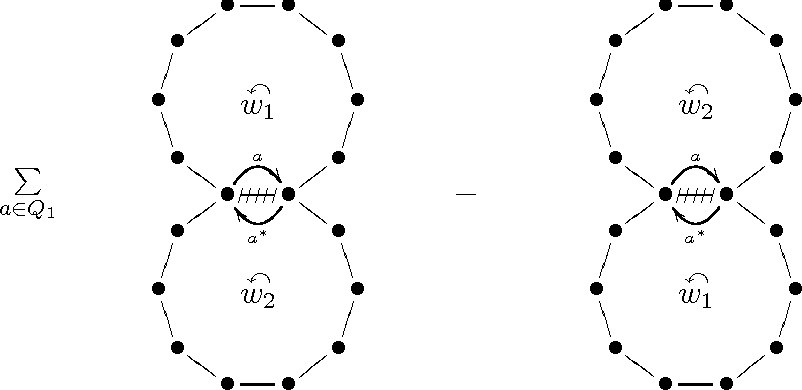Geometric invariant theory and quivers
In my PhD Thesis The Geometry of Quotient Varieties of Quivers I classified all quivers Q and dimension vectors d such that the quotient space classifying all semi-simple d-dimensional representations of Q is a smooth variety. The main result was that these quivers settings could be reduced via some elementary reduction steps
to three cases:

Together with Geert van de Weyer, Jan Adriaensens and Stijn Symens, I extended these methods to investigate singularities that can occur in these varieties, the properties of the fibers of the quotient map and other geometric objects associated to noncommutative algebras like character varieties, moduli spaces, graded representation spaces and Brauer-Severi varieties.
Noncommutative symplectic geometry
Together with my supervisor Lieven Le Bruyn I also studied the connection between noncommutative symplectic geometry, preprojective algebras and a type of infinite dimensional Lie algebras called Necklace Lie Algebras. We showed that certain moduli spaces of representations of preprojective algebras can be seen as coadjoint orbits of these Lie algebras.
Calabi Yau Algebras
A Calabi-Yau algebra is an algebra A with a selfdual projective bimodule resolution. These are nocommutative analogs of complex orientable varieties. F.i. the polynomial ring is a commutative Calabi-yau algebra. Another source of Calabi-Yau algebras are group algebras of compact orientable manifolds and preprojective algebras. I have shown that every positively graded 3-dimensional Calabi-Yau algebra must come from a superpotential. Together with Michael Wemyss and Travis Schedler we extended the superpotential method to arbitrary dimensions in the case that the algebra is Koszul.Noncommutative crepant resolutions
An important problem in algebraic geometry is the resolution of singularities. Given a singular variety, on wants to construct a proper surjective birational map from a smooth variety to the singular one.

There are many ways to do this but one tries to find a resolution that stays as close as possible to the singularity. An example of such resolutions are crepant resolutions and they are compatible with the notion of a canonical divisor.
It is also possible to construct noncommutative crepant resolutions. If R is the coordinate ring of a Gorenstein singularity then a noncommutative crepant resolution will be a Calabi-Yau algebra with R as its center. In the case that the 3-dimensional Gorenstein singularity is toric I was able to show that the algebra comes from a combinatorial structure called a Dimer model.
Dimers
A dimer model can be seen as a quiver drawn on a torus, such that the arrows go round in cycles around pieces of the torus. The Jacobi algebra is then the path algebra of the quiver subject to a set of relations. For every arrow we identify the two paths in opposite direction on the left and the right of the arrow.

I constructed a program such that for every toric gorenstein 3-singularity spits out all possible dimer models. I also investigated the combinatorial conditions on dimer models that are needed to give rise to an NCCR.
Homological mirror symmetry
I have been investigating the connection between dimer models and homological mirror symmetry. I associated to each dimer model two categories: a category of matrix factorizations and a Wrapped Fukaya category. I was able to show that one can construct a duality on dimer models that interchanges these 2 categories. This fact could then be used to recover the commutative mirror symmetry for punctured surfaces.
I used this result to interpret toric systems associated to strongly exceptional sequences of line bundles on Fano surfaces as an instance of mirror symmetry. I also investigated the connection between constructing different commutative crepant resolutions out of a noncommutative one and its connection with tropical curves and dynamical systems on dimer models.